Day 2: Isla San Esteban and San Pedro Martir
We went to bed right after dinner last night after we set sail. Although it was only 9:30 local time it was 12:30 back in Atlanta so we'd had a long day and I didn't get much sleep on the plane.
Last night the seas were surprisingly rough and the ship made creaking noises and banging as loose doors slammed shut.
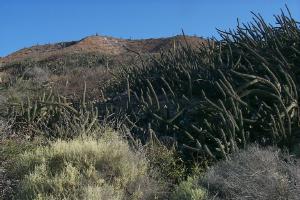
|
| Desert vegetation
|
This morning it was smooth again and the ship radio woke us up saying we were surrounded by common dolphins. I threw on some clothes, walked outside, looked down and there was a dolphin riding in our bow wave (which wasn't much because we weren't going that fast). So we were surrounded by one dolphin.
In the morning we went to shore on Isla San Esteban on the zodiacs. They have a dock on the back of the ship that is just a few inches above water so it is easy to get on the zodiacs.
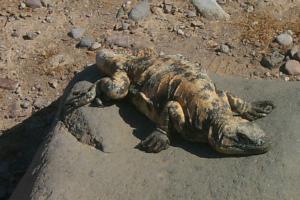
|
| Chuckwalla
|
We opted for the long tour (2 miles) but the guide said this would just be a hike and she didn't know that much about wildlife. So we went on the medium one with William who gets very excited about everything. The objective was the elusive chuckwalla, an iguana-sized lizard that lives under rocks and this species is endemic to San Esteban. While looking for the lizards we were introduced to all the different types of cactus and other desert plants. The big cactus are cardon cactus (not saguaro but that's what they look like), cholla (which dies and makes a spiral hollow stick), palo verde (which has green limbs), leatherbush (with rubbery stems) and the sweet pitahaya and sour pitahaya.
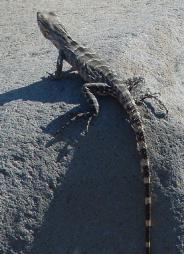
|
| Striped lizard
|
There were also agave (related to the century plant and a variety of which is used to make tequila). Saw mesquite which grows the deepest root of any plant, and jojoba and ironwood. On the beach were yellow-legged gulls and a couple of juveniles. When we got back to the boat there were some sea lions heading out our way. They came right up to the boat.
After returning around 10 the boat lifted anchor and set out to look for marine life. We saw more common dolphins which are black on top and white on bottom. Then a whale was sighted which turned out to be a humpback.
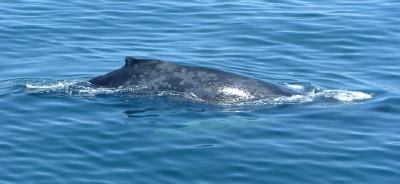
|
| Humpback Whale
|
These are migratory and not supposed to be here at this time of year. It kept popping up around the ship every few minutes, typically surfacing just as the camera was turning itself off after inactivity. It was easily within 100 feet of the boat and you could hear it expel air when it surfaced. It got close enough to see its flukes under water and we would sometimes see its tail go above the water when it would dive.
After a siesta we were told there were bottlenose dolphins off the port side. So I got up and looked out the door and there they were but I didn't have time to get the camera. Soon after some more whales were sighted off in the distance. These turned out to be small brown sperm whales. They were far off enough that the binoculars really helped and they would spout quite a bit. As the boat drifted we slowly approached three whales and they wound up just off the bow so that you could see their tails underwater. Again their tails would come out of the water sometimes when they would dive.

|
| Sperm Whales
|
Also saw brown boobies and blue footed boobies but haven't seen them plunge diving yet.
After the whale watching we arrived at the Isla San Pedro Martir. This island is completely white because it is covered in bird guano. As you get up closer you see that it is also covered in birds. There are thousands of brown pelicans, and tons of boobies. Their blue feet aren't so prominent now because it isn't mating season. We also saw Heermann's gulls which made a pleasant (for a gull) almost meow noise. There were a couple of babies there too although the rest of the birds were not nesting. We saw a good many red-billed tropic birds and fewer cormorants and terns. We went all the way around the island in the zodiac which was more guano than I ever needed to see. There were many barking sea lions and one very large bull.
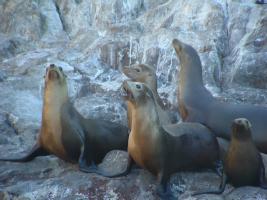
|
| Barking Sea Lions
|
After cocktails they started our recap lecture but I was taking a shower so I was late. William was talking about some obscure plant when I arrived. Very soon thereafter Jed, the expedition leader, interrupted and said there were dolphins and sperm whales outside. We saw spouts from several whales but they didn't come as close as before. The sperm whales stay at the surface for a while spouting at an angle to oxygenate their blood and then dive for a while. They don't actually fill up their lungs with air like humans do. The dolphins put on a good show and some that were further away were jumping way out of the water, maybe 15 feet high. We delayed dinner so we could keep watching but eventually went down to dinner anyway. As we walked into the dining room there was the largest sperm whale we had seen yet about 200 feet from the boat. Oh well, time to eat. We had dinner with a 94 year old Austrian woman who now lives in California and two Mexican guys who work for Lindblad in La Paz on the landside shuttling passengers from the boat to the airport. They are funny and very nice. Daniel is from Guadalajara and Enrique is getting a masters degree and wants to help with a center that will do dolphin therapy with handicapped kids. They were both extras in the movie Troy with Brad Pitt which was filmed partly in Baja.
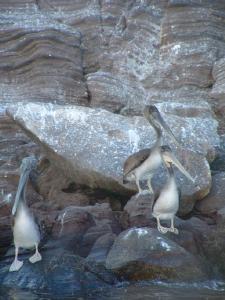
|
| Pelicans
|







